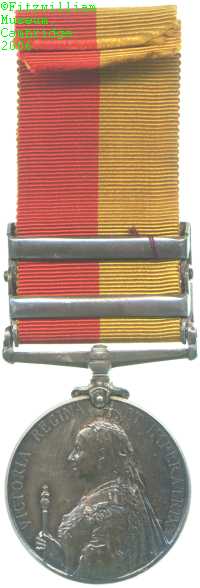
Obverse, a bust of Queen Victoria with crown, veil and sceptre

Reverse, Britannia at left with a trident standing facing right and gesturing to sky before a British lion

Obverse, a bust of Queen Victoria with crown, veil and sceptre |

Reverse, Britannia at left with a trident standing facing right and gesturing to sky before a British lion |
British rule in East Africa was partly achieved via the British East Africa Company, which acquired possessions in Uganda that the Government took over in 1895, and partly through an agreement with Germany in 1890 which had assigned a German protectorate in what is now Kenya to the Company. Subsequent British attempts to provide a modern transport and revenue infrastructure, at the expense of traditional local custom (or indeed just at the expense of locals) resulted in varying degrees of unrest, and for campaigns against such difficulties Queen Victoria approved this medal in 1899.
The clasp for Lubwa's refers to the fort of a chief, Lubwa, in the Uganda Protectorate near Jinja in modern Uganda. The fort was taken over in 1897 by a group of Sudanese troops who had defied orders to go on an expedition. The clasp was awarded for the engagement that drove them out of this position; they were finally defeated at Kabagambi, in modern Uganda. This was one of a number of such actions against these and other mutineers and rebels; for participation in these other campaigns the Uganda 1897-98 clasp was awarded, but it was also granted to those who had participated in the Lubwa's Fort expedition.
This medal was awarded to Sepoy Kale Khan of the 1st (Baluch) Battalion of the Bombay Light Infantry, part of the Indian Contingent in Africa, who presumably fought at Lubwa's Fort and probably continued to serve in the area thereafter. Lester Watson purchased his medal from the London dealers Spink at some point before 1928.
The Museum must acknowledge the assistance of Major Harry Fecitt in clarifying the details of this campaign.